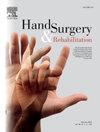Twenty-Year National Trends in Finger Fracture Epidemiology: Declining Incidence, Demographic Disparities, and Digit-Specific Injury Patterns
IF 1
4区 医学
Q4 ORTHOPEDICS
引用次数: 0
Abstract
Background
Finger fractures are among the most common upper extremity injuries, with significant functional and socioeconomic implications. While prior studies have described the general epidemiology of finger fractures, there is limited data on longitudinal trends, digit-specific patterns, and differences in injury mechanisms by demographic groups in the United States.
Methods
A retrospective analysis was performed using the National Electronic Injury Surveillance System (NEISS) database to estimate national trends in finger fracture incidence from 2004 to 2023. Cases were identified using specific diagnosis and body part codes, with narrative keyword filtering to determine the affected digit. Demographic variables, injury mechanisms, and annual incidence rates were analyzed. Trends were assessed using linear regression, and differences between groups were evaluated with Odds Ratios and Injury Proportion Ratios.
Results
A total of 109,317 finger fractures were reported over the twenty-year study period, representing a nationally estimated 3,693,924 finger fractures. The average annual incidence was 59.0 per 100,000 person-years. Males accounted for 65.4% of total cases, with a male-to-female incidence ratio of approximately 2:1. The thumb (26.42%) and little finger (26.15%) were the most frequently fractured digits, followed by the ring finger (15.29%), middle finger (14.53%), and index finger (12.06%). The most common causes were football (11.7%), basketball (11.5%), and doors (9.8%). There was a 46% decline in emergency department finger fracture rates from 2004 to 2023 (p < .01), driven primarily by reductions in the 0–18 and 19–40 age groups. Rates in adults over 40 remained stable.
Conclusion
This comprehensive, longitudinal analysis demonstrates a significant decline in emergency department finger fracture incidence in the United States over the past two decades, with notable demographic and mechanistic patterns. These findings highlight the importance of age- and activity-specific prevention strategies, continued surveillance, and targeted interventions to further reduce the burden of finger fractures, particularly among vulnerable populations such as older adults and children.
20年全国手指骨折流行病学趋势:发病率下降、人口统计学差异和手指特异性损伤模式。
背景:手指骨折是最常见的上肢损伤之一,具有重要的功能和社会经济意义。虽然先前的研究描述了手指骨折的一般流行病学,但在美国,关于纵向趋势、手指特定模式和损伤机制差异的数据有限。方法:利用国家电子伤害监测系统(NEISS)数据库进行回顾性分析,估计2004年至2023年全国手指骨折发生率的趋势。使用特定的诊断和身体部位代码来识别病例,并使用叙事关键字过滤来确定受影响的手指。分析了人口统计学变量、损伤机制和年发病率。采用线性回归评估趋势,采用优势比和损伤比例比评估组间差异。结果:在20年的研究期间,共报告了109,317例手指骨折,代表了全国估计的3,693,924例手指骨折。年平均发病率为59.0 / 10万人-年。男性占总病例的65.4%,男女发病率比约为2:1。拇指(26.43%)和小指(26.14%)骨折发生率最高,其次是无名指(15.30%)、中指(14.53%)和食指(12.06%)。最常见的原因是足球(11.7%),篮球(11.5%)和门(9.8%)。从2004年到2023年,急诊科手指骨折发生率下降了46% (p结论:这项全面的纵向分析表明,在过去20年里,美国急诊科手指骨折发生率显著下降,具有显著的人口统计学和力学模式。这些发现强调了针对年龄和活动的预防策略、持续监测和有针对性的干预措施的重要性,以进一步减轻手指骨折的负担,特别是在老年人和儿童等弱势群体中。
本文章由计算机程序翻译,如有差异,请以英文原文为准。
求助全文
约1分钟内获得全文
求助全文
来源期刊

Hand Surgery & Rehabilitation
Medicine-Surgery
CiteScore
1.70
自引率
27.30%
发文量
0
审稿时长
49 days
期刊介绍:
As the official publication of the French, Belgian and Swiss Societies for Surgery of the Hand, as well as of the French Society of Rehabilitation of the Hand & Upper Limb, ''Hand Surgery and Rehabilitation'' - formerly named "Chirurgie de la Main" - publishes original articles, literature reviews, technical notes, and clinical cases. It is indexed in the main international databases (including Medline). Initially a platform for French-speaking hand surgeons, the journal will now publish its articles in English to disseminate its author''s scientific findings more widely. The journal also includes a biannual supplement in French, the monograph of the French Society for Surgery of the Hand, where comprehensive reviews in the fields of hand, peripheral nerve and upper limb surgery are presented.
Organe officiel de la Société française de chirurgie de la main, de la Société française de Rééducation de la main (SFRM-GEMMSOR), de la Société suisse de chirurgie de la main et du Belgian Hand Group, indexée dans les grandes bases de données internationales (Medline, Embase, Pascal, Scopus), Hand Surgery and Rehabilitation - anciennement titrée Chirurgie de la main - publie des articles originaux, des revues de la littérature, des notes techniques, des cas clinique. Initialement plateforme d''expression francophone de la spécialité, la revue s''oriente désormais vers l''anglais pour devenir une référence scientifique et de formation de la spécialité en France et en Europe. Avec 6 publications en anglais par an, la revue comprend également un supplément biannuel, la monographie du GEM, où sont présentées en français, des mises au point complètes dans les domaines de la chirurgie de la main, des nerfs périphériques et du membre supérieur.
 求助内容:
求助内容: 应助结果提醒方式:
应助结果提醒方式:


